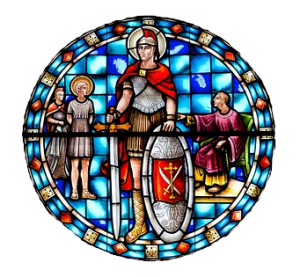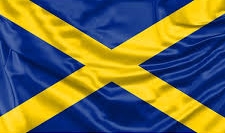Who is Saint Alban?
Who is Saint Alban?
 Saint Alban is venerated as the first recorded British Christian martyr, and is considered to be the British protomartyr.
Saint Alban is venerated as the first recorded British Christian martyr, and is considered to be the British protomartyr.
Along with his fellow saints “Amphibalus,” Julius, and Aaron, Alban is one of four named martyrs recorded from Roman Britain. He is traditionally believed to have been beheaded in the Roman city of Verulamium (modern St. Alban’s Cathedral) sometime during the 3rd or 4th century, and his cult has been celebrated there since ancient times. – Wikipedia

The Saint Alban’s Cross is a yellow saltire on a blue field (azure a saltire or). It is found in several flags, notably that of the Cathedral and Abbey Church of St Alban, previously a Benedictine monastery, and the city of St Albans, Hertfordshire.
It is the heraldic emblem that is commonly attributed to the Anglo-Saxon Kingdom of Mercia. A saltire is attributed to Mercia in College of Arms Ms. L.14, dating from the reign of Henry III (d. 1272). The arms were subsequently[year needed] used by the Abbey of St Albans. With the dissolution of the Abbey and the incorporation of the borough of St Albans the device was used on the town’s corporate seal and was officially recorded as the arms of the town at an heraldic visitation in 1634.[1] The cross has also been incorporated into a number of coats of arms, such as Hertfordshire county council and those of Mercian towns, including Tamworth, Leek and Blaby. Display of the Saint Alban’s Cross in flags is modern. Such flags are flown[year needed] from Tamworth Castle. The flag was flown outside Birmingham Council House during 2009 while the Staffordshire Hoard was on display in the city, and is shown in street signs in Tamworth, the “ancient capital of Mercia”.
